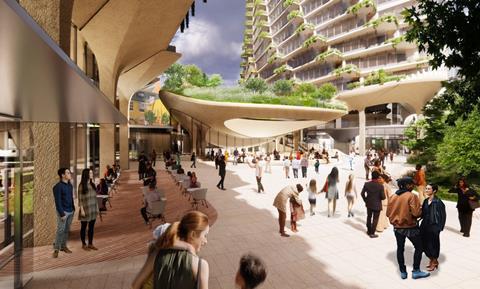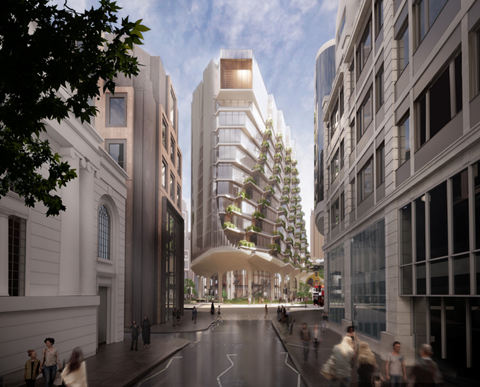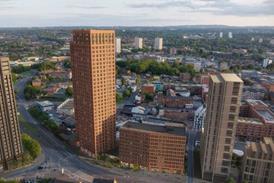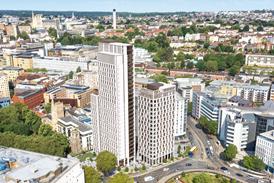Square Mile councillors voted to approve Diller Scofidio & Renfro scheme this morning following intervention by Gove

The City of London’s plans to redevelop the former Museum of London site are “completely at odds” with the local authority’s own sustainability policy, according to the Twentieth Century Society.
This morning the City voted in favour of proposals designed by Diller Scofidio & Renfro and Sheppard Robson to replace the site’s 1970s buildings with an office scheme including two towers.
The decision has been rendered moot by Michael Gove’s intervention yesterday to issue an Article 31 Holding Direction, preventing the council from approving the scheme to allow the secretary of state time to decide whether or not to call it in.
> Also read: Gove puts Museum of London demolition plans on ice hours before committee hearing
The move is a major setback for the plans, which were recommended for approval by the City’s planning officers but have received nearly 1,000 objections from locals and campaigners raising concerns about the embodied carbon impact of demolishing the existing buildings, which also include the Bastion House tower.
It comes just weeks after the Square Mile formally approved plans to require developers to prioritise retrofit options in schemes instead of demolishing and replacing existing buildings.

A spokesperson for the Twentieth Century Society said the group welcomed Gove’s intervention and criticised the council’s vote to back the plans, which came in at 16 votes in favour and eight against with one abstention after a debate lasting more than three hours.
“The decision today by the City of London Corporation’s Planning and Transport Committee to green-light the development is completely at odds with their own new sustainability policy, launched in December 2023, that commits to ‘the reuse of existing buildings’,” C20 said.
“The former Museum of London and Bastion House are buildings that are well suited to adaptive retrofit, and provide the City with a perfect opportunity to lead by example.
“C20 Society now urges Michael Gove to call in the application and fully review it at a Public Inquiry: Refuse it, then reuse it!”
Other major schemes called in by Gove in recent years on carbon and heritage grounds include Make’s 72 Upper Ground and Pilbrow & Partners’ plans to redevelop Marks & Spencer’s Marble Arch store.
While the former was approved following a public inquiry, the latter was rejected by the communities secretary in a decision which was later overturned by the High Court, which found that Gove had misinterpreted the national planning policy framework (NPPF).
But Estelle Dahon KC, speaking in this morning’s planning committee meeting on behalf of the Barbican Quarter Action Group, said Gove would be less likely to face the same “stumbling blocks” if he rejected the plans for the former Museum of London site.
“The key problem the secretary of state had in the M&S decision is that he hung the whole embodied carbon assessment on the NPPF and on the carbon policy in the framework that says there needs to be radical reductions in greenhouse gas emissions,” Dahon said.
Gove had argued that the NPPF implied that there was a strong presumption against demolition in planning decisions, an interpretation which the High Court said went too far
But Dahon suggested the approach could hold in the event of a High Court appeal of a rejection of the Museum of London scheme because of the City’s retrofit policy.
“This situation is very different because this committee is dealing with a local plan that has in policy terms a presumption against demolition,” she said.

“And this committee is dealing with a policy situation where there’s the planning advice note put in place under that policy that requires the applicant to do the option analysis and to consider alternatives.
“So the two big stumbling blocks that brought down Gove over M&S simply don’t arise here.”
The City said an assessment of whole life carbon emissions per square metre had found that demolition and redevelopment of the site “achieved the most sustainable outcome when taking into account potential floorspace uplift, wider environmental and public benefits, public realm provision and the ability to deliver new and leading-edge sustainable buildings for the site.”
However, the assessment found that this approach had the highest whole life carbon emissions of all options considered because of the overall size of the development.
Planning officers argued that the scheme should still be approved because the new buildings would be more efficient in terms of operational energy and would “future-proof” the site with high levels of urban greening, climate resilience and connectivity with surrounding areas.
A City of London Corporation spokesperson said the City “acknowledges the Section 31 Holding Direction issued by the Department for Levelling Up, Housing and Communities and will await the Secretary of State’s final decision.”
















No comments yet